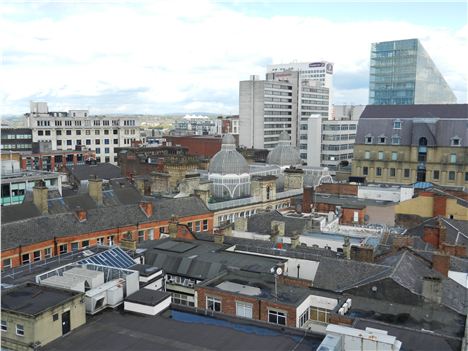FOR three years owners in No1 Deansgate have been fighting for the Right To Manage (RTM) Manchester’s most prestigious block for themselves.
At one point CBRE was put on notice for corporate manslaughter when they admitted that the external glass louvres, an integral part of the structure of the building, had not been maintained for a number of years.
They decided that, triplex penthouse or no triplex penthouse, paying upwards of £500,000 a year to maintain a building that was less than ten years old was just too much.
They are up against a freeholder determined to oppose them and lawyers who argued that a slim piece of flashing, put up to stop litter and leaves blowing through a gap, means the building is now attached to the block next door.
This ludicrous argument has been going on for years, through tribunals and courts, costing residents upwards of £30,000 in legal fees.
Every ruling so far has gone the owners’ way but each time the decision is appealed and the case goes up to a higher court.
Their latest win was in November last year when the Upper Tribunal (Lands Chamber) threw out the objections to their Right to Manage.
Judge Nicholas Huskinson who made the ruling noted: “I was told that if the weathering features between the building and the neighbouring buildings were removed then there would be a gap between the buildings down which one could notionally drop a pebble so that it fell vertically to the ground between the buildings.”
Pebble sized problems can cost hundreds of thousands
But lawyers for the building’s freeholder, the global giant TRW Pensions, have confirmed that they will be asking for the right to appeal again, this time to the Court of Appeal.
The man leading the Right to Manage action is Steve Birkbeck. He said: “It is incredibly frustrating. Each time we win and each time they appeal. Our fear is that because nationally more owners are going for RTM we could be seen as a test case on this issue and we could have to argue our case all the way to the Supreme Court and find the necessary legal costs for that which does not seem fair.
“It is a ridiculous situation where this thin piece of flashing, put up after the building was completed to stop leaves and litter, is standing between us and the right to make decisions that affect our own properties.
“We have produced the architectural designs by Ian Simpson, photographs of the building during its construction, all manner of evidence and all the tribunals and courts so far agree, yet still we find ourselves in limbo.
“It is totally against the spirit of the law.”
No1 Deansgate Steve Birkbeck points out the gap
The Commonhold and Leasehold Reform Act of 2002 was designed to give owners of apartments the right to manage their block themselves if more than 50% of them agreed. While it’s not a responsibility to be taken lightly there are several buildings in Manchester where the residents are in charge and can appoint managing agents.
No.1 Deansgate is run for the pension fund by CBRE Global Investors, which appointed itself in the form of CBRE Asset Management as managing agent.
For the owners in No1 the tipping point came when the service charges for the building went from high to exorbitant. In 2008 the bill for maintaining the building and its 82 apartments was £558,297 – way over the agreed budget of £378,000. The following year it was still in excess of £500,000.
Some stopped paying the service charge. A few went to court and reached their own compromise agreement.
They had a meeting with CBRE and it became clear that budgets were not being met, work was being paid for and not being done and worse, essential maintenance was not being carried out.
No 1 Deansgate
At one point CBRE was put on notice for corporate manslaughter when they admitted that the external glass louvres, an integral part of the structure of the building, had not been maintained for a number of years.
Stephen said: “They are a key safety feature and it was obvious they had not been checked regularly because no service people had been into the apartments. If they had then no-one had seen them and no-one had been told, so technically if they had they would have been breaking and entering.”
They eventually won back around £90,000 in service charges after the landlord accepted that the maintenance had not been carried out but had been billed to the residents.
In 2010 the residents notified CBRE that they were starting the Right to Manage process and in January 2012 Living City was brought in to manage the building by the landlord.
The service charges have since dropped considerably; down to £355,000 and assuming this is what the service charges should have been in previous years, Steve calculates that they have paid £900,000 over the odds since the building was completed the back end of 2002.
When they do eventually get the Right to Manage, and they will, the building will be managed by Mark Habib whose Block Property Management company won the contract after a tender process.
Steve said: “We are confident we can bring the service charges down even further. People think it is all footballers and TV stars who live here but I own a small apartment on the first floor which is probably worth less now than when I bought it over a decade ago.
“Any reduction in fees is a huge benefit.
“The high levels of service charge have also been a factor in re-sales. When buyers find out they may have to pay £6,000 a year for a two bedroom apartment they think again.
“Getting to this stage has been hard work, hundreds and hundreds of e-mails, contributions to legal fees, gathering evidence, all for something that is enshrined in law and should be very simple.
“But with escalating fees we just felt helpless and this was the only way to go to regain control.
“We will know soon if TRW have been given leave to appeal again. If they have we will just have to argue it all over again.”
Confidential asked CBRE for a statement but received nothing in return.
The full ruling can be read here: No1 Deansgate RTM UT
You can follow Jill Burdett on Twitter here
 Barton Arcade domes and No 1 Deansgate from St Ann's Church tower
Barton Arcade domes and No 1 Deansgate from St Ann's Church tower













